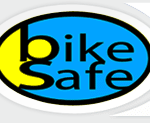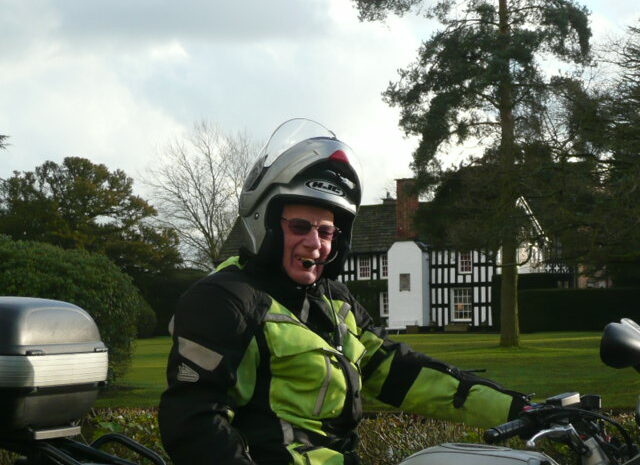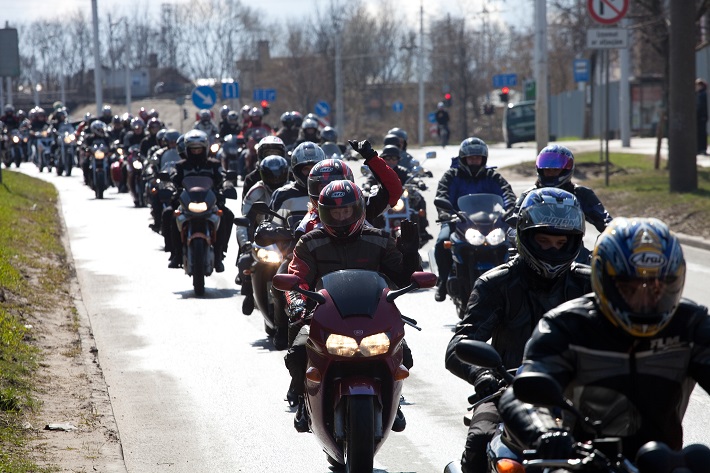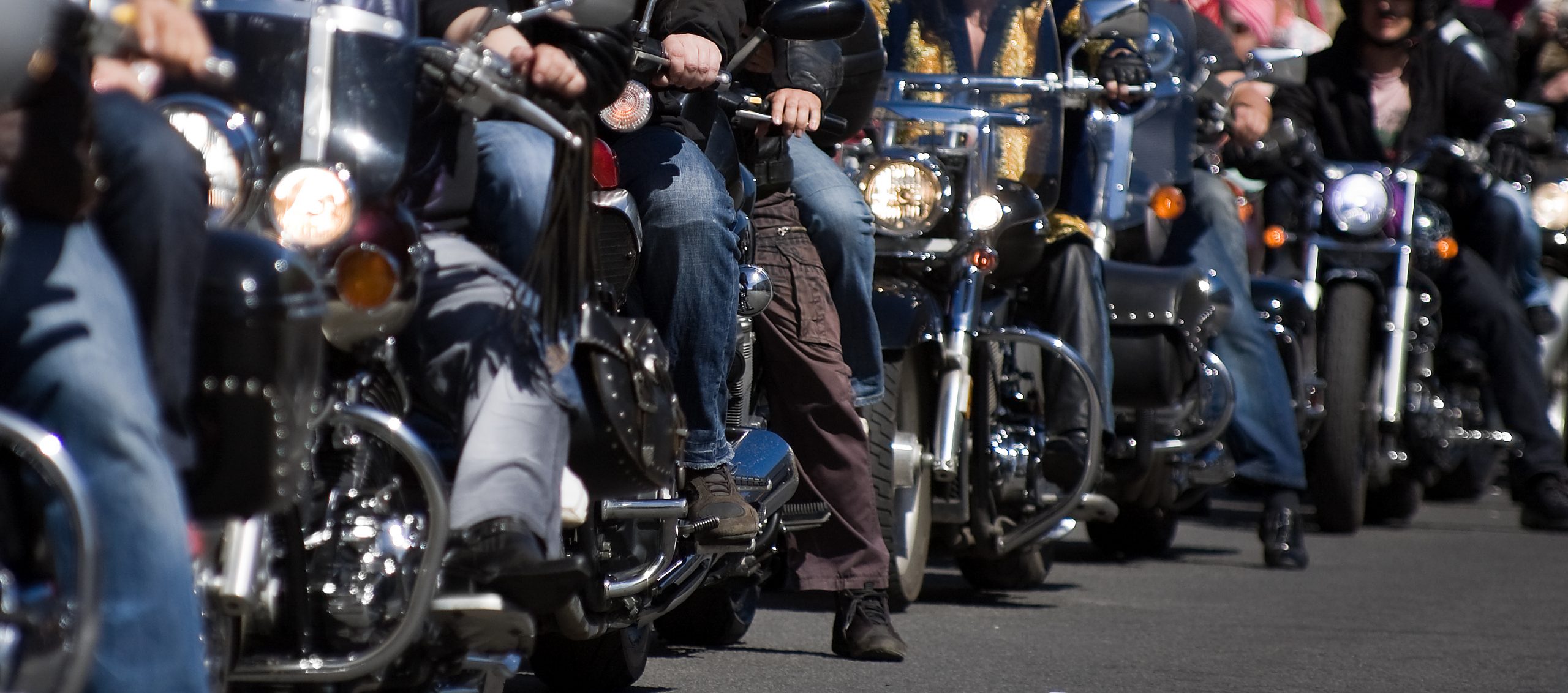For his second Devitt blog, qualified bike instructor Bill Whitelaw has shared some great advice and tips with us on riding in groups. His excellent blog discusses how to ride safely for those much anticipated long summer group ride-outs.
“I live in Cheshire, close to the Macclesfield/Buxton Road, otherwise known as the Cat and Fiddle due to the fact that the Cat and Fiddle pub is at the highest point of the road. This leads us into the Peak District of Derbyshire and during any nice evening or weekend, we see many bikers out for a ride, usually in groups. The social side of biking is amazing! No matter where you see bikers, they will be checking out the other bikes and chatting with their peers. It does not matter what their background or job is, they are all bikers, just happy to talk about their bikes and their experiences.
Although some arrive individually, most arrive and leave in groups and riding in a group can be a great experience. However, it can also be risky and there are some sensible precautions that we should take to reduce the risks especially if you are new to the group.
So, what are the risks?
- The biggest risk is that the pace that the group set is quicker than you are going to be comfortable with.
- The group may know the roads well and you may not.
- There may be an idiot in the group?
- It may become a race!
- You could become separated from the group.
- Biking tends to have a macho image and it can be difficult to accept that your riding skills are not as advanced as the other group members.
How do we reduce these risks?
- Firstly how well do you know the other members of the group? (see note at end)
- How many are in the group?
- Does the group have rules that everyone in the group understands?
- Is there a plan of where you are going? Agree a route and destination with rest points so that if you become separated, you can make for the next agreed stop to meet up without being under pressure to catch up.
- How far will you be going? Will you need fuel soon?
- Swap mobile phone numbers with a couple of other riders.
- Meeting point and destinations are often pubs. Remember that alcohol and bikes are a fatal combination. NO ALCOHOL.
Obviously any group must have a leader and possibly a tail end Charlie. The leader should set a pace that allows everyone to keep up and should stop from time to time to bring everyone back together especially after passing through a busy area with traffic lights, roundabouts etc that can split the group up or a quick bit of road where speed limits may not have been observed. (Surely not)
Tail end Charlie has a more difficult task, especially if there is a problem such as a breakdown or a rider who is uncomfortable with the pace and is dropping back. Ideally they will be in radio contact with the leader and therefore able to inform of any problems.
Using the second rider drop off system is a good way of keeping everyone on route. If you have not used the second rider drop off it is quite straight forward.
At any junction or round about where a turn is made, the second rider pulls over indicating which way to go and stays there until the last rider goes through. It is important that everyone knows how many are in the group. This way everyone gets to move up to second rider position and then drop to the back. It is not possible to mark motorway exits in this way, so if you are using motorways, it is necessary to pre-agree numbers of junctions where you are planning to leave the motorway. It is a good idea for the lead rider to slow down when approaching a motorway exit to allow everyone to bunch up and reduce the risk of losing someone.
So, you know where you are going and how you will be able to follow the route. What’s next?
In my opinion the number one rule of group riding is to stay within your comfort zone. Don’t be tempted to try and stay with quicker riders if this means that you are riding quicker than you are comfortable with. If necessary, allow others to pass you and drop back. You are out to enjoy yourself, not to scare yourself or your pillion. Just because the rider in front is going into a bend quicker than you, does not mean that they will get around it safely. It is all too easy to get into a semi hypnotic state just following the bike in front instead of reading the road and making your own judgements. Don’t be embarrassed by not keeping up with the bike in front. It will be more embarrassing if the other riders have to pull you and your bike out of the hedge or worse.
Sadly there are many reports of how riders have blindly followed the bike(s) in front that are overtaking, only to find that there is an oncoming car or another obstacle there, resulting in a collision. Wait until you can see that it is safe before overtaking. This might sound obvious but unfortunately it was not obvious to the casualties who followed through.
Sometimes the biggest risk comes from a member of the group! The show off who drops to the back and then comes overtaking everyone. If you ride with the same group on a regular basis you will know who this is and may even choose to find a new group.
Be considerate of other road users. It is quite frightening for a car driver to look in the mirror and see a bunch of bikes with headlights on sitting right on their bumper. There is a serious risk that they will panic and without thinking hit the brakes. If traffic is congested we can filter past but should not force cars to brake to let us in, this could result in the driver acting stupidly and pulling out in front of the next bike or sitting right on your back wheel. Discourtesy is an unsafe way of riding because it causes aggressive reactions from the other drivers and this increases the risks to us. We are out to enjoy ourselves, let’s not spoil it for others.
One of the benefits of going out with a bunch of other riders is that some of them may be more competent than you and it’s unusual to find someone who will not be willing to offer you some advice. However, there are also those whose abilities aren’t in line their high perception of themselves, so be careful on what advice you listen to. If it is apparent that your skills are not up to those in the group, then why not get in touch with your local BikeSafe group. This scheme is run by the police and they will assess your riding and recommend local trainers as appropriate. www.bikesafe.co.uk
Alternatively, you could contact a local DVSA approved ERS instructor.
You could also contact your local Roadar or IAM groups. However, in my experience the standard varies from group to group.
Whether you are simply going out for a couple of hours, a 200 mile, all-day run or a continental tour, set your own agenda, ride at a pace that you are comfortable with, enjoy every minute of your ride and return home safely.I have had some great times going out with groups, but I have also experienced some stupid and downright dangerous behaviour by group members and sadly seen the results of this stupidity.

Alternatively, you could contact a local DVSA approved ERS instructor.
You could also contact your local Roadar or IAM groups. However, in my experience, the standard varies from group to group.
Whether you are simply going out for a couple of hours, a 200 mile, all-day run or a continental tour, set your own agenda, ride at a pace that you are comfortable with, enjoy every minute of your ride and return home safely. I have had some great times going out with groups, but I have also experienced some stupid and downright dangerous behaviour by group members and sadly seen the results of this stupidity.

A few weeks ago, Michelin were planning the dealer launch of the new Pilot Road 4 tyres and were inviting dealers to Stoke on Trent for the launch. They asked me if I would organise ride outs into Cheshire and Derbyshire so that the dealers could test the tyres on some interesting roads. I included the Cat & Fiddle and Snake Pass into the route, as well as some other twisty roads. On the first day I ended up with a couple of riders who were obviously competent riders and after a while they took off on a rather twisty section of road and I went after them, but despite making some serious progress, could not catch them. Eventually they were waiting for me. It was a couple of weeks later that I learned that I had been guiding multiple TT winner Phillip McCallen. It makes sense to know who is in your group!
As a matter of interest, I am writing this whilst in Turkey having ridden down through Croatia, Bosnia, Montenegro, Albania and Greece with friends but that is a tale for another day.”
Bill Whitelaw


4 comments on “Group riding: The advantages and the dangers”
I’m amazed to see this article sponsored by an Insurance company; for many years the risk of litigation against anyone organizing runs has been clear. Anyone doing so may be held legally liable for any actions within the group no matter what and an insurance company may be happy to forgo the the responsibility. Despite the lack of precedence, run organisers may stand to lose everything they own.
Sad state of affairs!
Nanny state and damned litigation lawyers and a justice system that has taken a wrong turn themselves somewhere!
Sadly the culture of ‘it must be someone else’s fault’ is a risk no matter what we do.
However most group rides are simply a bunch of mates out for a ride. They may be from a local club or just live locally and are all bikers.
There is no real organiser and that is why I suggested having a few simple rules in order to make the ride more enjoyable and safer.
Personally I am involved with ride outs sponsored by major dealers. In this case we have insurance cover because the Dealer has Devitt
Dealer Cover and I have Devitt Professional Indemnity cover should anything go wrong and whilst there is no absolute protection, getting everyone to sign a ‘Disclaimer’ prior to setting out is a good idea.
So whilst it is correct to point out that there is a risk of being sued it is possible for guides to protect themselves.
So whether you are going out with a bunch of mates or on an organised run just take simple pre-cautions before you go and if you are the organiser and do not have PI insurance make sure that everyone signs a
Disclaimer to say that you accept no responsibility and everyone participates at their own risk.
Bill Whitelaw